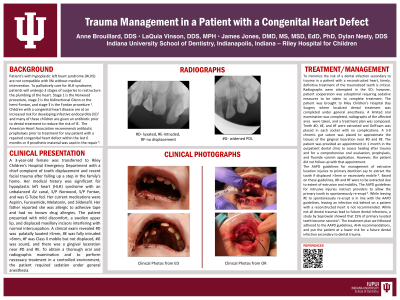Trauma
552 - Trauma Management in a Patient with a Congenital Heart Defect


Anne Brouillard, DDS
Pediatric Dental Resident
Indiana University, Bloomington, IN
Riley Children's Hospital/Indiana University School of Dentistry
Fortville, Indiana, United States- LV
LaQuia A. Vinson, DDS, MPH
Associate Professor
Indiana University, Bloomington, IN
Indianapolis, Indiana, United States
Presenting Author(s)
Program Director(s)
Introduction: Traumatic dental injuries of primary teeth are common in children. These injuries can have lasting effects including pain, malocclusion, malfunction, injury to the developing permanent teeth, and decreased esthetics. Treating displaced, fractured, or avulsed primary teeth on patients with a complex medical history and difficult behavior management presents as a challenge.
Case Report: This presentation discusses a 3-year-old female who was transferred to Riley Children’s Hospital Emergency Department with a chief complaint of recent facial trauma and tooth displacement. The patient was in mild discomfort, had a swollen upper lip, and displaced maxillary incisors interfering with normal intercuspation. The patient’s medical history was significant for hypoplastic left heart (HLH) syndrome with an unbalanced AV canal, S/P Fontan, S/P Norwood, and was G-Tube fed. Her current medications were Aspirin, Furosemide, Melatonin, and Sildenafil. Her father reported she was allergic to adhesive tape and had no known drug allergies. To obtain a thorough oral examination and to perform necessary treatment in a controlled environment, the patient required sedation under general anesthesia. This case report will detail the steps of the dental rehabilitation process beginning with the first encounter in the emergency department, to clinical and radiographic findings in the operating room, the completed treatment, and follow-up care for a young patient with a congenital heart defect.
Identify Supporting Agency and Grant Number:

.jpg)